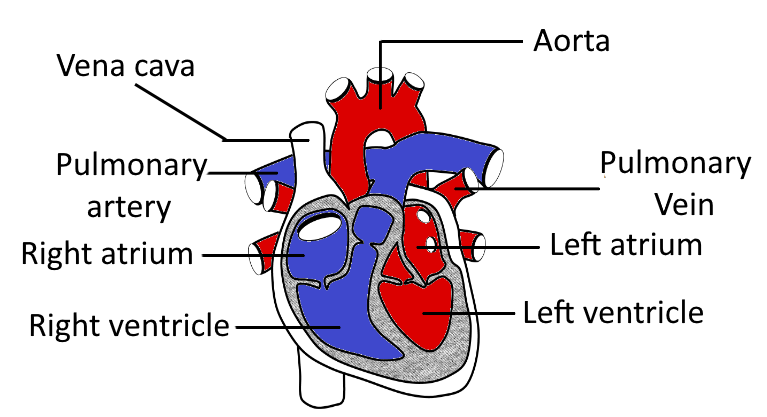
The pulmonary artery carries deoxygenated blood from the _____ to the lungs.
(a) Left ventricle
(b) Right ventricle
(c) Left auricle
(d) Right auricle
Answer
486k+ views
Hint: In human beings, the left half of the heart is associated with the circulation of pure i.e., oxygenated blood while the right half is involved in the circulation of deoxygenated blood.
Complete answer:
Our heart consists of four chambers out of which the two relatively small upper chambers are called atria or auricles while the two relatively larger lower chambers are called ventricles. If we consider the heart in two parts as left and right, each half will have one auricle and one ventricle and named as the right auricle, right ventricle, left auricle, and left ventricle. The left auricle receives oxygenated blood from the lungs through the pulmonary vein and this oxygenated blood is pumped by the left ventricle in all the parts of the body through the dorsal aorta. From the body parts, the right auricle receives deoxygenated blood through vena cava and this deoxygenated blood is pumped to the lungs by the right ventricle through the pulmonary artery. Here, the blood is made oxygenated through gaseous exchange and is then circulated through the heart again. The right ventricle and pulmonary artery can be seen in the diagram below -

So, the correct answer is “Right ventricle”.
Note:
- The human circulatory system is also known as double circulation because there are two pathways involved in the complete circulation of blood throughout the body. One is the pulmonary pathway which is between heart and lungs and the other is a systemic pathway that connects the heart to the rest of body parts.
- Aorta is the largest artery that carries the blood from the heart into the systemic circulation.
Complete answer:
Our heart consists of four chambers out of which the two relatively small upper chambers are called atria or auricles while the two relatively larger lower chambers are called ventricles. If we consider the heart in two parts as left and right, each half will have one auricle and one ventricle and named as the right auricle, right ventricle, left auricle, and left ventricle. The left auricle receives oxygenated blood from the lungs through the pulmonary vein and this oxygenated blood is pumped by the left ventricle in all the parts of the body through the dorsal aorta. From the body parts, the right auricle receives deoxygenated blood through vena cava and this deoxygenated blood is pumped to the lungs by the right ventricle through the pulmonary artery. Here, the blood is made oxygenated through gaseous exchange and is then circulated through the heart again. The right ventricle and pulmonary artery can be seen in the diagram below -

So, the correct answer is “Right ventricle”.
Note:
- The human circulatory system is also known as double circulation because there are two pathways involved in the complete circulation of blood throughout the body. One is the pulmonary pathway which is between heart and lungs and the other is a systemic pathway that connects the heart to the rest of body parts.
- Aorta is the largest artery that carries the blood from the heart into the systemic circulation.
Recently Updated Pages
Questions & Answers - Ask your doubts

Master Class 11 Accountancy: Engaging Questions & Answers for Success

Master Class 11 Science: Engaging Questions & Answers for Success

Full Form of IASDMIPSIFSIRSPOLICE class 7 social science CBSE

In case of conflict between fundamental rights of citizens class 7 social science CBSE

Can anyone list 10 advantages and disadvantages of friction

Trending doubts
10 examples of friction in our daily life

The correct order of melting point of 14th group elements class 11 chemistry CBSE

Difference Between Prokaryotic Cells and Eukaryotic Cells

One Metric ton is equal to kg A 10000 B 1000 C 100 class 11 physics CBSE

What is the specific heat capacity of ice water and class 11 physics CBSE

State and prove Bernoullis theorem class 11 physics CBSE




